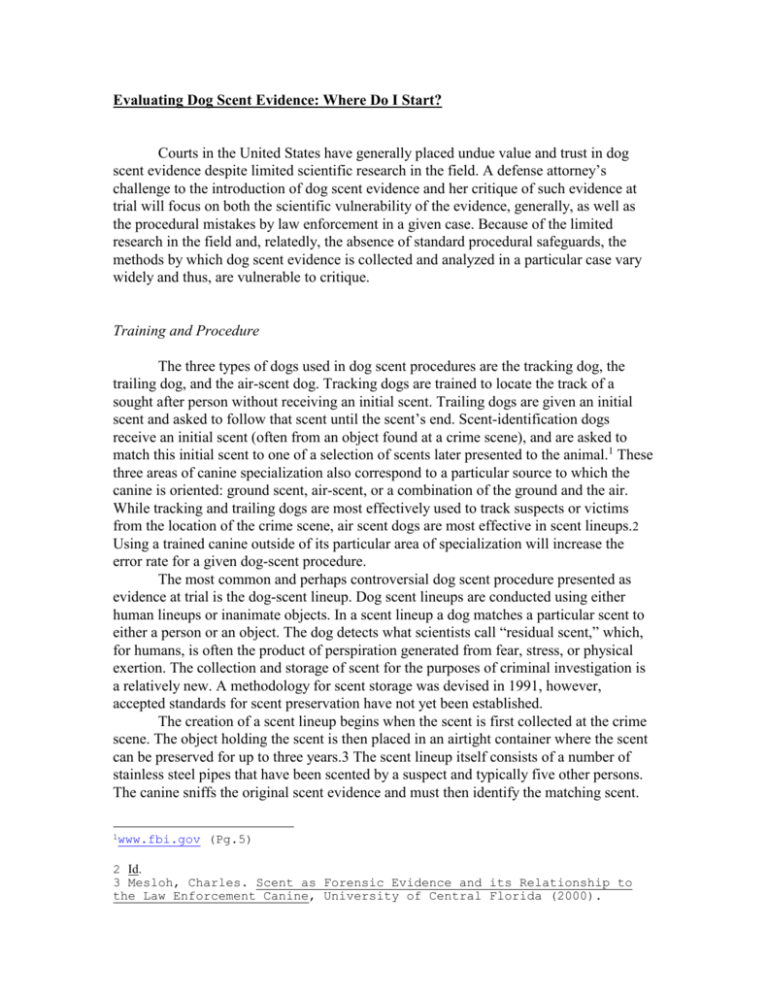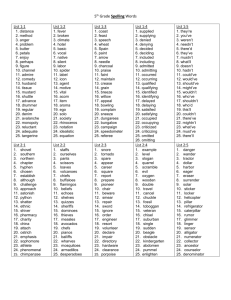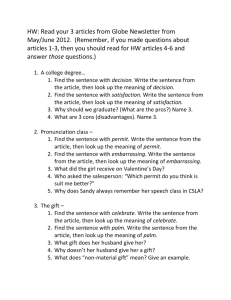Evaluating Dog Scent Evidence: Where Do I Start
advertisement

Evaluating Dog Scent Evidence: Where Do I Start? Courts in the United States have generally placed undue value and trust in dog scent evidence despite limited scientific research in the field. A defense attorney’s challenge to the introduction of dog scent evidence and her critique of such evidence at trial will focus on both the scientific vulnerability of the evidence, generally, as well as the procedural mistakes by law enforcement in a given case. Because of the limited research in the field and, relatedly, the absence of standard procedural safeguards, the methods by which dog scent evidence is collected and analyzed in a particular case vary widely and thus, are vulnerable to critique. Training and Procedure The three types of dogs used in dog scent procedures are the tracking dog, the trailing dog, and the air-scent dog. Tracking dogs are trained to locate the track of a sought after person without receiving an initial scent. Trailing dogs are given an initial scent and asked to follow that scent until the scent’s end. Scent-identification dogs receive an initial scent (often from an object found at a crime scene), and are asked to match this initial scent to one of a selection of scents later presented to the animal.1 These three areas of canine specialization also correspond to a particular source to which the canine is oriented: ground scent, air-scent, or a combination of the ground and the air. While tracking and trailing dogs are most effectively used to track suspects or victims from the location of the crime scene, air scent dogs are most effective in scent lineups.2 Using a trained canine outside of its particular area of specialization will increase the error rate for a given dog-scent procedure. The most common and perhaps controversial dog scent procedure presented as evidence at trial is the dog-scent lineup. Dog scent lineups are conducted using either human lineups or inanimate objects. In a scent lineup a dog matches a particular scent to either a person or an object. The dog detects what scientists call “residual scent,” which, for humans, is often the product of perspiration generated from fear, stress, or physical exertion. The collection and storage of scent for the purposes of criminal investigation is a relatively new. A methodology for scent storage was devised in 1991, however, accepted standards for scent preservation have not yet been established. The creation of a scent lineup begins when the scent is first collected at the crime scene. The object holding the scent is then placed in an airtight container where the scent can be preserved for up to three years.3 The scent lineup itself consists of a number of stainless steel pipes that have been scented by a suspect and typically five other persons. The canine sniffs the original scent evidence and must then identify the matching scent. 1www.fbi.gov (Pg.5) 2 Id. 3 Mesloh, Charles. Scent as Forensic Evidence and its Relationship to the Law Enforcement Canine, University of Central Florida (2000). Located on one of the steel pipes.4 Scrutinizing Procedure The scrutiny applied to scent-identification procedures should extend well beyond the purported error-rate experts assign to a given procedure. When examining a particular lineup the defense attorney should probe any number of variables, which impact the error rate for a particular scent-identification lineup. The variables specific to the examined lineup can impact the lineup’s reliability, causing it differ significantly from the error rate noted in scientific studies testing the given procedure. The following is a partial list of variables that should be examined in testing the reliability of a scent-identification lineup: • • • • • • • • • • • • Method of scent collection Method of scent preservation Error rate assigned to particular procedure Error rate documented for canine used in procedure Canine’s training history Total number of scents presented Similarity of the scents presented Dog’s previous knowledge of the scents presented Number of identification procedure conducted Independence of trials; number of dogs, number of comparative traces Presence of a handler Certification of canine An inquiry into any one of these variables should be facilitated by research that explains the relevance of the particular variable. As mentioned above, this list is not comprehensive, but should provide a sense of the factors most likely to impact a scentidentification procedure. “Top Ten” Sources on Dog-Scent Evidence Most of the sources listed below offer a basic introduction into the science and/or law of dog-scent identification evidence. Curran, A. M. and Furton, K. G. Optimization of Collection and Storage Methods for Scent Evidence and the Identification of the Volatile Components Comprising an Individual Human Odor Signature. Presented at the American Academy of Forensic Sciences, Dallas, Texas, 2004. Kanable, R. Collecting scent as evidence, Law Enforcement Technology (June 2003):1304 Id. 134. S. Chapman, Police Dogs in North America 9-10 (1990) (quoting M. Ross, The Book of Noble Dogs 34 (1922)). L. Whitney, Dog Psychology: The Basis for Dog Training 57 (1973). Schoon, G.A.A., 2001. The influence of experimental setup parameters of scent identification lineups on their reliability. Problemy Kryminalistyki 236: 43-49. Schoon G. A. A., De Bruin J. c. (1994). The ability of dogs to recognize and cross-match human odours. Forensic Science International, 69, 111-118. Schoon G.A.A. (1998). A first assessment of the reliability of an improved scent identification line-up, Journal of Forensic Sciences, 43, 1, 70-75. Settle R. H., Sommerville, B. A., McCormick J., Broom, D.M. (1994). Human scent matching using specially trained dogs, Animal Behaviour, 48, 1443-1448. Sommerville B. A., Settle R. H., Darling F.M.C., Broom D.M. (1993). The use of trained dogs to discriminate human scent, Animal Behaviour, 46, 189-190. *Taslitz A.E.: Does the nose know? The unscientific myth of the dog scent lineup, “Hastings Law Journal” 1990, 42 pp. 15-134. The Dog as a Detective, Sci. Monthly January 1924, at 45 (discussing psychological factors in scent lineups.)









